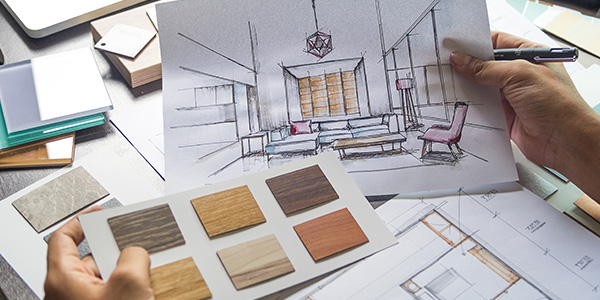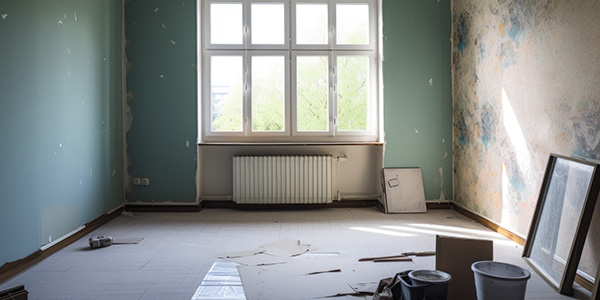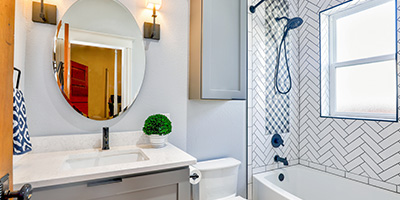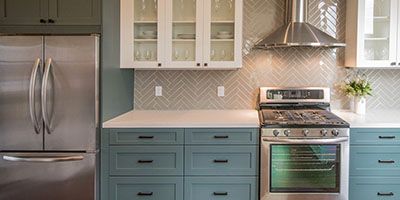Home Renovation Guide: How to Plan a Whole House Remodel in 8 Steps

How to Plan a Home Renovation From Start to Finish
Starting a home renovation is an exciting time, as you’re one step closer to making your dream home a reality. But when you get into the details, it can also feel overwhelming – especially if you’ve never completed one before. That’s why you need to plan your remodel well in advance. Use our tips for planning a home renovation to keep your worries at bay and your job on track.
Step-by-Step Home Renovation Checklist
1. Build a Detailed Home Remodel Plan
Building a plan is crucial if you’re renovating a house with no experience. First, you should outline the work that needs to be done. This includes stating the end goal for your renovation and providing design inspiration for contractors. You should also note which rooms you want to renovate and which ones you plan to leave as-is.
Your project plan should also include:
- A list of steps that you know you can DIY
- A list of steps that you plan to hire a professional for
Take Time to Research Permits
You should start investigating local zoning regulations and permits early on in planning your home renovation. Make sure your neighborhood allows for your specific remodel (some renovations, like converting your garage into a room, are not allowed everywhere) and find out if you need a permit. If you’re completing a project that will change the structure of your home or how you use a room, you’ll most likely need to contact city officials.
If you do need a permit, wait to apply until you’ve hired a team and settled on a timeline. Your contractor may need to obtain a building permit depending on where you live.

3 Things to Consider While Planning Your Home Remodel
There are three key factors to keep in mind as you decide how to plan your remodeling project:
- Your budget
- The condition of your property
- The desired outcome of your renovation
The Size of Your Budget
How much you’re planning to spend on a home renovation determines the scope of your project. We’ll cover how to set a realistic budget for your remodel in step two of this post.
The Condition of Your Property
Remodeling a fixer-upper is more expensive and time-consuming than renovating a house that’s already in good shape. Remember this as you start planning your whole house remodel, as it impacts your budget and the projects you take on.
The End Goal of Your Project
Preparing to put your house on the market or flip a property you just purchased? Set on living in your home for the foreseeable future? Whatever your life plans are, map out your home renovation accordingly. If you’re interested in raising resale value, you should tackle remodeling projects that increase ROI. But if you’re updating your home to better suit your lifestyle, start thinking about rooms you spend the most time in.
When to Start: 6 to 12 months before your start date
2. Set a Budget for Your Project
The next step in planning a home remodel is determining how much you’re willing to spend. Your budget should include the costs for permits and building materials, labor as well as cosmetic touches.
If your cost estimates don’t fit into your budget, use your home improvement project plan from step one to eliminate elements of your job that are a lower priority. You should also request estimates from multiple contractors to find the best option for you.

“When you remodel a home, pay attention to your budget so you don’t overbuild in your neighborhood. For instance, if you get the top-of-the-line appliances, flooring, counters and cabinets for your kitchen remodel and it is far above what other homes have in the neighborhood, you may not get your money back. Many homeowners take their eye off of their budget and realize that they overspent on their project when the bill comes.”
Elizabeth Dodson, Co-Founder | HomeZada
Want to avoid overspending on your next remodel? Learn how to budget for your home renovation with our helpful guide.
Choose the Right Materials for Your Home Remodel
Materials are always one of the biggest costs for any remodel. Your renovation costs can change dramatically depending on the materials you use for construction. For example, choosing a high-end handmade tile that ships from Italy can skyrocket your budget. If you’re looking for ways to save, opt for materials that are more common, like a classic bright-white subway tile. Here are some general guidelines for material costs when installing the following:
- Hardwood floors: $3 to $10 per square foot
- Tile floors: $3 to $10 per square foot
- Cabinets: $80 to $90 per cabinet
- Countertops: $40 to $100 per square foot
- Paint: $25 to $100 per hour if you hire a painter
When to Start: 6 to 12 months before your start date

3. Hire Contractors
Once you’ve built a home remodeling plan and set a budget, you’ll need to hire your team. At this point in your renovation plan, you should know which projects you’ll complete yourself and which ones you’ll hire out for. Don’t choose your contractors based on cost estimates alone. When interviewing and selecting your contractors, think about:
- Years of experience: A contractor with several years of experience may be a safer bet than one who is new to the business.
- Contracting license: Make sure your contractor has gone through all the steps needed to get certifications specific to their line of work. Please note your contractor may not need a license depending on the state you live in.
- Certificate of insurance: Contractors should have workers’ compensation and liability insurance for the type of work they perform.
- References: Request and call references. This is a great way to make sure your contractor isn’t just good on paper. It’s always a good idea to check out online reviews, too.
- Payment schedule: A reputable contractor won’t ask you to pay the full price upfront, and the Better Business Bureau advises not to. However, it’s important to discuss payment terms before construction begins. In some cases, it’s better to spend a little extra to get someone you’re comfortable working with.
4. Decide Which Projects You’ll Tackle First
As you plan your remodel, consider which projects you’ll take on first. To prevent big issues later on, we recommend tackling messy, large-scale home improvements before focusing on the smaller details. If you’re working with a contractor, consult with them to make sure you’re on the same page. It’s important to note the order of your remodel process affects when you schedule crews for different parts of your project.

“Where you start your home remodel depends on what’s important to you as a homeowner and how much you want to spend. Kitchen and bathroom remodels add value to your home but cost a lot of money and can take more time to complete. Maybe finishing out a basement, updating the flooring in your family room or adding a patio to your backyard will add value to your property and the time spent with your family.”
Elizabeth Dodson, Co-Founder | HomeZada
How to Organize Your Home Remodel
Start With Utilities
You can’t live in your dream home without electricity or running water! Before you make any major home improvements, check that your plumbing, HVAC and electrical lines are all in place. If you’re adding onto your home in any way, from building an addition to putting in another bathroom, it’s important to think about and add any necessary utilities before you start building. If you don’t do this first, you’ll have to backtrack so your new appliances and fixtures run properly.
Move Onto Large Projects
If you’re changing your original floor plan or building onto your home, put that project at the top of your list. Making large, time-consuming home improvements will save you hours of work down the road. Don’t plan on making any major home upgrades? Start with the room you spend the most time in.
Schedule Smaller Projects Towards the End
It’s a good idea to make minor home updates toward the end of your remodel. This includes installing new lighting fixtures and tackling small room renovations, like converting your spare bedroom into an office. For this step, focus on giving your home personal flair.
Save Finishing Touches for Last
Once your appliances and fixtures are installed, you can decorate the inside of your home. This includes choosing paint colors for each room and hanging curtains. Read our guide to make the best interior design choices for your house.
For organization, use a calendar to plan each step of your remodeling project. Confirm with your team that your timeline is realistic and keeps you within budget. According to House Beautiful, here’s how long it typically takes to renovate each room of your home.
- Kitchen: 3 to 12 weeks
- Bathroom: About 3 weeks
- Room Addition: 6 to 12 weeks
- Basement: About 3 weeks
- Deck: About 1 week
- Roof Replacement: About 2 days
When to start: 2 to 3 months before your start date
5. Set a Timeline for Your Project
Once you have a budget and team in place for your remodeling plan, set a timeline. First, choose a desired start date. If you’re hoping to have it completed by a specific time, work backward from that date. Consult with your contractors to determine how long each portion of the project will take. You should also discuss which steps of the remodel process need to be completed first, how long they will take and which can be completed concurrently.
Additionally, make sure your timeline:
- Includes time to clean out the project area.
- Allows for the shipping and delivery of materials.
- Accounts for any holidays your contractor may take off.
- Includes a few days’ worth of wiggle room for each step in case of unexpected issues.
When to start: 2 to 3 months before your start date.

6. Plan for Problems When Remodeling
Even the most detailed home remodeling plans go awry. Don’t let it get you down. Prepare for unexpected issues by setting aside a chunk of your budget and allotting a few extra days in your timeline. This helps you reduce stress and spend less throughout the remodel process. Listed below are three common problems that come up during home renovations — keep them in mind as you complete your project.
Common Renovation Problems to Look Out For
- Foundation cracks. Foundation damage is one of the most expensive problems homeowners can face. If you notice two or more of these foundation issues in your house, you should call a professional.
- Water damage. It’s not uncommon for water damage to put home remodels behind schedule. If you find damage from leaks and floods in your home, your contractor must assess how severe it is and fix the problem. This will put any ongoing renovation projects on hold.
- Outdated electrical work. If your electrical work isn’t up to code, update it to keep your house safe. Plus, old wiring can’t handle the power generated by modern appliances, which you’ll probably install during your home remodel.

7. Prepare for Your Renovation
Now that your home project planning is nearing an end, prep your first room and try to avoid using it while it’s under construction. Whether you should live in your home during construction depends on the projects you’re completing. If you’re flipping a property to put it on the market, you don’t have to worry about being inconvenienced. Regardless, you must prepare each room of the house before getting to work.
- Kitchen remodel: If you’re remodeling your kitchen, build a temporary place to cook and remove all your dishes as well as major appliances. It’s a good idea to clean out your refrigerator and pantry so nothing goes to waste.
- Bedroom remodel: When renovating your bedroom, find somewhere to store your furniture and make new sleeping arrangements. To avoid excess clutter, pack away any clothes you don’t plan to wear in the foreseeable future.
- Bathroom remodel: If your whole family is only using one bathroom until you’re done remodeling your bathroom, condense the number of products you use. It might be helpful to schedule a bathroom routine for each family member to avoid traffic jams.
- Basement remodel: Before renovating your basement, make sure you don’t have to worry about any code violations. You should also check with city officials to see if you need a permit.
If you’re remodeling your whole house in one fell swoop, you might want to move out completely for a short period of time. Whatever your situation looks like, make any necessary adjustments so you can live comfortably until your home renovation is complete.
When to start: Make plans 2 to 3 months before your start date; pack up 1 to 2 weeks before your start date.
Planning a renovation? That's a lot of cleanup. A dumpster can help. Here's what you need to know.

8. Plan Ahead for Your Cleanup
It’s easy to forget about cleanup when you’re planning a big project. Don’t wait until your contractor is piling concrete in your driveway to think about waste removal. Factor the cost of getting rid of debris into your budget and make sure to discuss plans with your contractor before starting your job. If your contractor won’t haul away your trash and leftover building materials, decide whether you should rent a dumpster or make several trips to the dump yourself.
When to Start: 2 to 3 months before your start date



